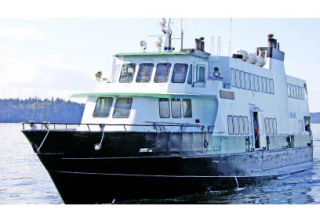King County this week assumed the cost of providing passenger-only ferry service between Vashon and downtown Seattle, a move that marks the beginning of the county’s eventual full operation of a route that for years has been provided by Washington State Ferries.
The county decided to create a ferry district that would take over the popular passenger-only service after the state Legislature, which is grappling with the high cost of ferry service, voted in 2006 to end state funding for passenger-only ferries. Last April, the county created a ferry district, overseen by the nine-member county council, funded by a property tax of 5.5 cents per $1,000 of assessed value. That tax will provide a yearly budget of $18.3 million for the ferry district, providing funds to cover the costs of the Vashon-Seattle route, year-round operation of the West Seattle Water Taxi and the development of five other demonstration routes across Lake Washington and Puget Sound.
In an effort to ensure a smooth transition, the transfer of the Vashon-Seattle route is taking place in phases. The county’s ferry district took on the costs of operating the service on Tuesday, July 1; the state ferry system continues to operate it. The county ferry district will assume operation of the route in July 2009. David Moseley, who heads the ferry system, said there will be no route or fare changes this year.
“We are working closely with the King County Ferry District for a seamless transition,” he said in a news release.
Christine Lund, the new head of the county’s ferry district, visited Vashon last week, where she told members of the Vashon-Maury Island Community Council’s transportation committee that the Vashon-Seattle run is the prototype for the kind of service the ferry district hopes to offer elsewhere. She also told the group that the ferry district plans to eventually purchase faster ferries that are more fuel-efficient than the current one, which is very inefficient.
Kari Ulatoski, who heads the transportation committee and attended the meeting, was encouraged by Lund’s comments and the county’s determination to gradually assume full operation of the run.
“If it weren’t for the King County Council, Vashon would not even have a PO boat anymore,” she said.
In a related development, state ferry officials who were on Vashon last week at a ferry advisory committee (FAC) meeting said the ferry system plans to have four cameras installed by the end of July that will enable ferry-users to go online to determine the length of the ferry line at Vashon’s north-end terminal.
Steve Rodgers, the state ferry system’s director of operations who — with Moseley — attended the Vashon FAC meeting, said ferry system officials have wanted to install cameras for years but haven’t had the funding.
A breakthrough came after Transportation Secretary Paula Hammond, who visited Vashon earlier this year, heard Islanders’ complaints about the lack of cameras and directed the Transportation Department to find the funding. The state ferry system, until recently, was a separate agency, and not a part of the much larger Transportation Department. Now that the state ferry system is within that large, cabinet-level agency, Hammond has the clout to order Transportation officials to undertake projects in support of the ferry system, Rodgers said.
He said the cameras will help commuters determine the length of the ferry line and plan trips accordingly. It will help ferry workers as well, who currently can’t tell how far the line of cars extends up the hill and thus can’t coordinate effectively with Southworth ferry workers on how much room to allow on the shared route, he said.
Vickie Mercer, who attended the meeting, said she and other ferry-service advocates were glad to hear the news.
“We’ve been asking for these cameras since 2001,” she said. “I think this is pretty significant.”



